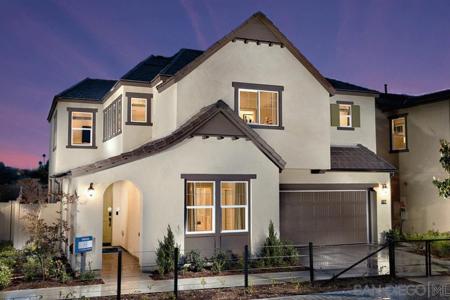
New San Diego Single-family Homes are Rare and Smaller
Those hoping San Diego County’s new home supply might increase overall home inventory will be disappointed. To start 2022, there are only about 1,000 new single-family homes confirmed by developers, with the bulk of new residential construction reserved for apartments and townhouses.
Roughly 1,000 new single-family homes confirmed to start the year is low compared to demand, and prices reflects that.
Costs for new homes range from nearly $700,000 to more than $2 million. The majority of new homes are in Chula Vista’s masterplan community of Otay Ranch, Valley Center’s Park Circle community, Fallbrook and 3Roots in Mira Mesa.
Housing experts said a large reason there aren’t more single-family home projects in San Diego County this year, or in the near future, is state and community planners are favoring denser development near transit. That means large single-family projects in rural San Diego — already likely to be voted down, not approved or stopped by legal action — could be a thing of the past.
It isn’t all doom and gloom for home shoppers because many developers have shifted into smaller home products that are still detached but are less pricey than some condos. For example, the Trailside project in Valley Center has homes around 2,000 square feet that start in the $630,000 range, and the Crestline project in Spring Valley has homes 1,700 square feet to 1,800 square feet that start in the mid- $600,000s.
“It is a good thing and a trend that has to continue,” said Gary London, a San Diego housing analyst. “It’s land use efficiency. Smaller homes, smaller lots and smaller prices all go together.”
The trend of smaller single-family homes is not yet at the same level as Japanese “pencil style” homes that dominate Tokyo suburbs, but it is a change for the region — especially after many of the large San Diego County projects that came out after the Great Recession.
For example, one of the biggest projects in the last three years has been the Sterling Heights community north of Black Mountain Ranch. The homes range from 4,936-square-feet to 6,540-square-feet. The project is now sold out but homes were selling for as much as $3.4 million in March 2021.
London said it’s true many San Diego homes were larger because that’s what local governing bodies were approving, but it’s not like developers had much motivation to push back on plans.
“They can make as much money, if not more, building the McMansion and selling to one person vs. 10 people,” he said.
Kerry Garza, founder and president of Park Circle master developer Touchstone Communities, said the size of its new Valley Center homes were based on how practical they were with local plans. San Diego County planners have been pushing for more than a decade for denser villages, which is how the development was approved under its general plan. But, he said he doubted the Valley Center community would approve of a very dense townhouse project so that is why they went for smaller, detached houses.
Garza said the result was creating a mix of homes that are in high demand.
The Park Circle masterplan, with 632 homes, started construction in summer 2019 in unincorporated San Diego County and has been a quick sell for all the developers involved. It is about 20 miles east of the coast and north of Escondido, making homebuyers more likely to be those who work in North County.
There are several developers working in the 186-acre Park Circle, including KB Home, Beazer Homes, Meritage Homes, Shea Homes and Richmond American Homes. Touchstone Communities said more than 7,000 people signed up on an interest list in early 2021 when the first sales started.
Park Circle could have included 700 more homes, based on what was approved for the master developer. It is a sharp contrast to Chula Vista’s Otay Ranch masterplan that has favored denser development with townhouses, apartments and, in some cases, smaller homes.
Like all new homes built in California this year, houses in Park Circle come with solar panels. The law requiring solar took effect in 2020, but projects that started before that were exempt. This is the first year in San Diego County where the majority of new homes come with solar.
Park Circle residents will all be allowed to use a large park, community center, gym, pool and hot tub in the center of the development. About 250 homes have been sold in Park Circle. Of those, 100 homes are occupied while the rest are still under construction.
The center of new home construction for the next few years will likely be the Côta Vera project in Chula Vista. It has space for 2,300 housing units spread out among townhouses, apartments, subsidized housing, condos and single-family homes.
The size of the project is even more intense when considering it is part of the Otay Ranch masterplan (nearly the size of San Francisco) that will include around 18,000 homes at final buildout.
The 400-acre Côta Vera will include trails, an urban core with retail, pool, an MTS rapid bus transit stop, gas station, fire station, park and elementary school. Luxury gym Lifetime Fitness recently signed a lease for a new structure in the masterplan’s urban core.
Like Park Circle, Côta Vera has a master developer — HomeFed Corp. — that sells plots to developers who have their own home types. Lennar is responsible for the Whitmore project, which maximizes space with small yards, shared driveways and built-up with two stories.
Almost all San Diego developments have set prices for new homes, making it rare that a buyer paid more for a house than a neighbor. For instance, when you go to other new home communities in Otay Ranch, a salesperson hands you a printout with the cost for its home types. Then, you get on a waiting list and, although it differs from developer to developer, it typically involves a lottery if demand is too high.
Mark Goldman, a real estate analyst with C2 Financial Corp., said Lennar had created a “silent auction” for homes but it made sense in the hot market. He said costs of materials keep going up, and with so few homes for sale, home prices keep increasing. Goldman related it to the resale market where homes are going for so much over asking potential buyers are often left stunned. “Nobody knows the price (the home will go for) — not even the builder,” he said.
Source: SDuniontribune by Phillip Molnar





